By Kiša Lala
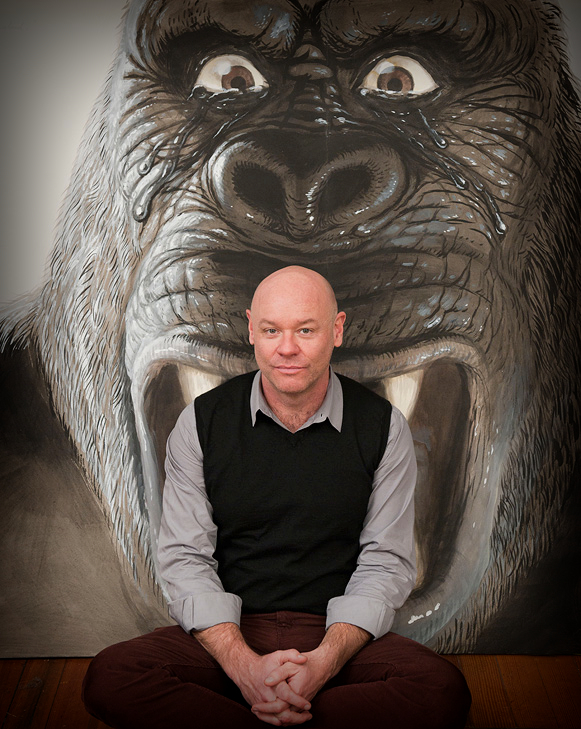
Walton Ford photographed by Bobby Fisher © Bobby Fisher, 2011 -- Arabian proverb from beginning of King Kong: 'And the Prophet said, 'And lo, the beast looked upon the face of beauty. And it stayed its hand from killing. And from that day, it was as one dead.'
A witty narrative of thwarted simian desire is the theme of Walton Ford's new series of watercolor paintings at Paul Kasmin Gallery. Ford's obsession with King Kong, the super-sized movie monster came from his childhood viewings of the 1933 cinematic tale of abduction depicting the clash of the beastly brute Kong and delicate, blonde sophisticate, famously played by Faye Wray.
The story is less Beauty and the Beast, more unrequited love akin to Nabokov's Lolita, in which Kong, the faux monster gorilla, is trapped by unnatural desire and vanity towards an act unacceptable to consummate.
In his other series, displayed like a comic strip narrative on the gallery walls, Ford returns to his earlier Audubon inspired style, depicting a scenario described in the naturalist's journals about his pet parrot. I chatted to Ford about his new work and flipped through his past drawings in my old copy of Pancha Tantra, a collection inspired by the ancient Sanskrit book of animal fables, possibly the oldest on the planet.

Walton Ford wearing one of his collection of gorilla masks, photographed by Bobby Fisher © Bobby Fisher, 2011

'The du pain au lait', Walton Ford © 2011 Courtesy of Paul Kasmin Gallery
I asked Ford about his inspiration for the story behind the monkey masturbating with the dead parrot, and Ford explained that Audubon's father was a ship's Captain. "He used to bring exotic animals home to France," said Ford, "Audubon himself was born out of wedlock: the Captain had a mistress in Haiti, and after Audubon was born from this mistress, the Captain brought the young boy home to his wife in France who raised Audubon."
"My mother had several beautiful parrots and some monkeys; one of the latter was a fully-grown male of a very large species. One morning, while the servants were engaged in arranging the room I was in, 'Pretty Polly' asking for her breakfast as usual, "Du pain au lait our le perroquet Mignnone,' the man of the woods probably thought the bird [was] presuming upon his rights in the scale of nature be this as it may, he certainly showed his supremacy in strength over the denizen of the air, for, walking deliberately and uprightly toward the poor bird, he at once killed it, with unnatural composure." John James Audubon
Ford reimagined the scenario from the few torrid tidbits left in Audubon's diaries, "I thought, how Freudian! I made it hyper sexualized. The incident actually traumatized him and led to him painting birds."
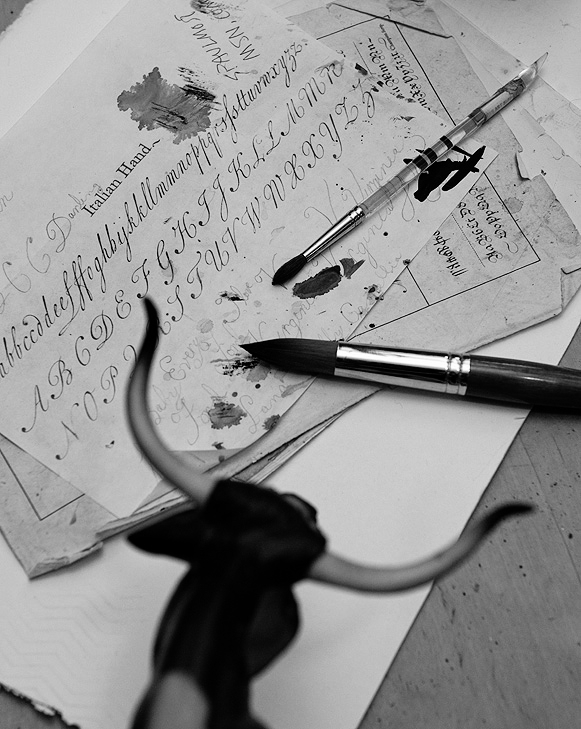
At Walton Ford's studio in Great Barrington, MA, photographed by Bobby Fisher © Bobby Fisher, 2011
Walton Ford's drawings recall a time when explorers roamed uncharted oceans, when rumors of primeval lands and exotic creatures fed our fears and dreams. Ford is attracted to the most documented of these journeys, which were accounts by western colonialists 'discovering' the east - the Orientalists.
In the film King Kong, travelers reach Skull Island, a lost world of colossal beasts and dinosaurs. The goliath jaws of Kong, which greets guests entering the gallery is an anachronistic caricature, no longer fearsome, and out of date. Kong's face, full of pathos, seems just as decontextualized now as he was misplaced then, out of the jungle, climbing the Empire State. He's molded from our fear of the wild, which lives as part of our psychic inheritance in the primordial fear of being eaten. On the other hand, one might say the nemesis of our modern fears comes from not what's lurking in the jungle but from aliens in outer space.
Animals have lost their potency and magic, their power over our subconscious. Hunting for sport replaces hunting for survival. Animals are 'game' on a planet where we're the dominant species. Zoos and safaris are the last remaining places left for modern man to face off against wild beasts, as some feel inclined to do, in macho, drunken bravado, foolishly discovering that their place in the food chain is not unconditionally secure.
But Ford believes, there are still places where animals command mythic status. Wolves still prey on our imagination as werewolves and vampires, possessing supernatural powers, haunting villages of rural France and Eastern Europe.
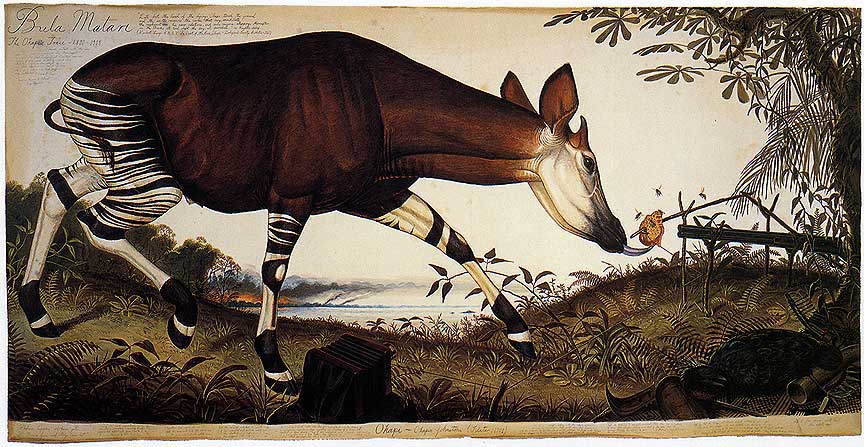
Bula Matari by Walton Ford, © Walton Ford
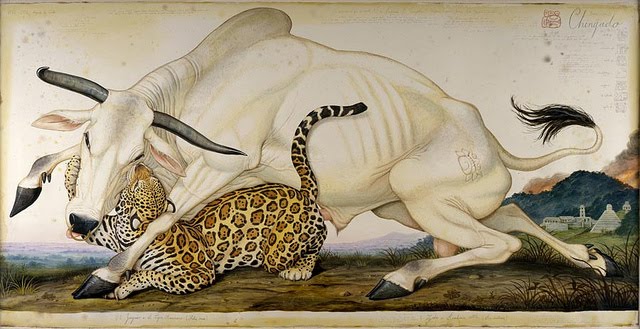
A Jaguar and Zebu's Death Caress: 'Chingado' by Walton Ford © Walton Ford - watercolor, gauche, pencil and ink on paper
I asked the artist why in many of his drawings in the Pancha Tantra the animals are chained or trapped, and the landscapes are burning - were humans always a threat? "It's not about man being destructive to nature, but about exploring the relationship, which often is violent. The pet monkey is chained... they are supposed to be surrogate humans, like court jesters and keep within certain rules of cute monkey behavior. If they behave like a monkey, it's upsetting."
Ford studied 19 century books of gun traps and snares on camp life and the tricks of trapping. "They are fables on the costs of pleasure, instant gratification." Ford points to a drawing of a tapir, "He is shot and photographed at the same time. They were destroyed as 'pests,' or trapped for their feathers and fur. Birdlime (a kind of glue) was used to trap hummingbirds inside flowers," says Ford, an avid connoisseur of odd animal trivia and arcane folklore.
Ford's watercolor paintings have evolved from a clinical stylized, technically perfect aesthetic that made his select pincered specimens appear as though isolated from their habitats, suspended within faux antique landscapes - and thus removed, the artist rendered his creatures exotic and extinct. "I like the idea of creating an artifact that isn't real; that couldn't have been made when it says it was," explains Ford.
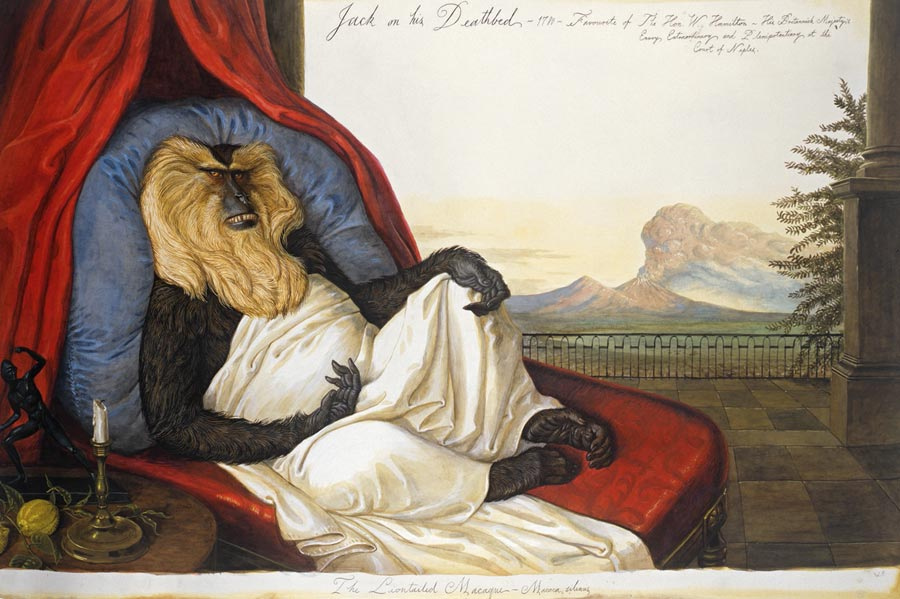
Jack on His Deathbed © Walton Ford - 'The battles between him and my Boy Gaetano when he is naked and going into the Sea with me in the morning are really curious. He never bites him but plays him all sorts of trick, his favourite one is to pull him by his (testicles) and then he always smells his fingers;' Excerpted from Fields of Fire: A life of Sire William Hamilton
Ford's later work turned towards wittier allegories taken from more extensive narratives, such as the lives of Richard Burton, explorer and first infidel in Mecca, Lord William and Emma Hamilton's Neapolitan society of debauched dandies, and the bawdy Earl of Rochester. Finally in the new Kong series, Ford has abandoned his predilection for the pre-photographic era with excessive detailing and marginalia borrowed from esoteric manuscripts, and courageously leaped into the early 20 century cinematic imagination. Though some anecdotal and literary diversions fire our reveries, the Kong portraits tackle emotions of love and rejection on our egos, (a gorilla's face is suitably more empathic and anthropomorphic for this purpose), and also allude to Ford's personal travails and recent divorce
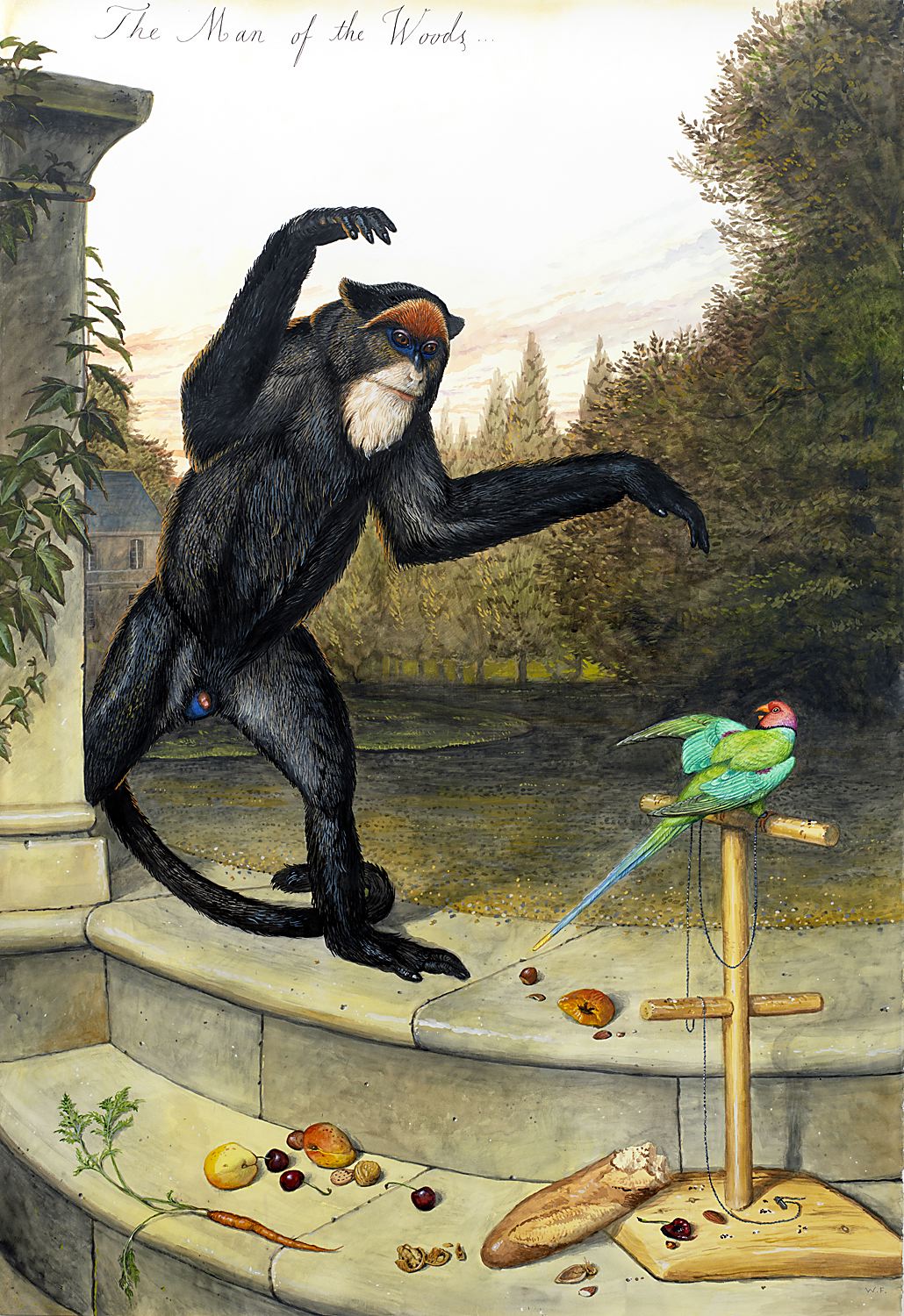
Man of the Woods, © Walton Ford, 2011 Courtesy of Paul Kasmin Gallery
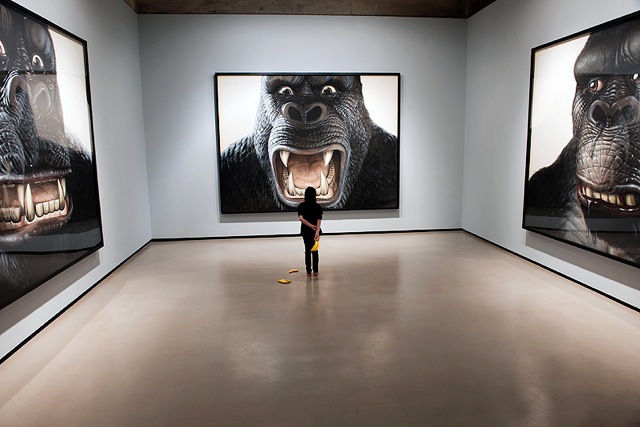
Installation view. Walton Ford at Paul Kasmin Gallery. Photo by Bobby Fisher
Not a real silverback gorilla, Kong's face was a Hollywood rendering made to elicit fear.
"It's from a mixture of film stills," Ford tells me. "They used a scale model for close-ups, and an animation model for stop motion. The proportions of the head are the same as I paint here. These are emotional portraits of what he was going through."
In the Hollywood parable, Kong is a cornered savage; the girl gets rescued and civilization scores a victory against the barbaric jungle. On the contrary, it would be more typical today to side with the animal -so totally vanquished is the wilderness in our imagination. Ford also, takes the animal's point of view, and makes Kong's emotions human.
"He has this overwhelming desire and lust for her and she's screaming, it's the worst kind of violation, he undresses her..." Ford says, building to the climax, "She escapes him and his reaction is rage. I imagine him heart broken. He kills everybody but he never sheds a tear, but goes through rage and grief."
The text refers to the end when Kong is chained up and the girl says, 'I don't like to look at him, it makes me think of that awful day on the island'. Ford finds the moment, ironically poignant, "And for him the awful day on the island was the best day for him - he had his girl, it was wonderful for him. They are so far apart at this point - her rejection of him is so complete. So it starts out with disbelief, then grief and rage, and an acceptance phase, when the romance is over."
Kong's been dumped, and Ford sees parallels in human behavior using the animal kingdom. The way we see nature, as a mirror of ourselves, is what fascinates Ford. It's the inauthentic, artificial frame we've imposed around it. "They are animals in the human imagination rather than animals in nature. Generally, when you see animals in nature they are not doing very much they are running or resting, it's not terribly interesting. There's a lot of 'animal nature' art, but almost all romanticize moments where there isn't a human viewer included in the image."
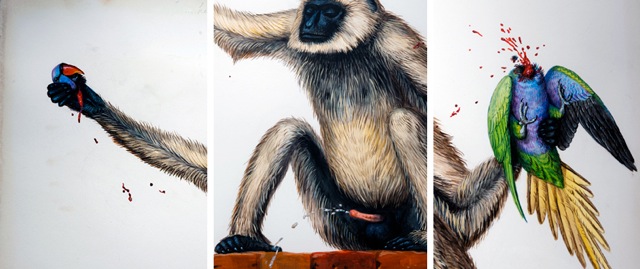
Photo montage of Walton Ford paintings by Bobby Fisher © Bobby Fisher
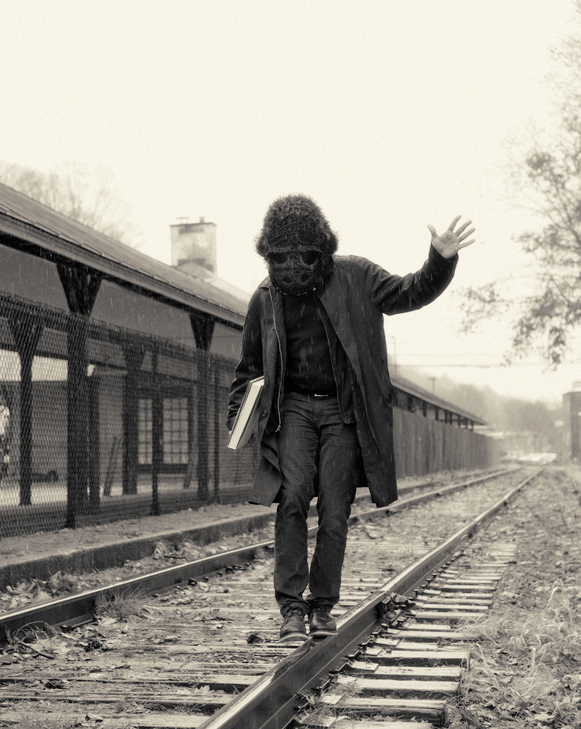
Walton Ford photographed by Bobby Fisher © Bobby Fisher
Text & Interviews: www.KišaLala.com
